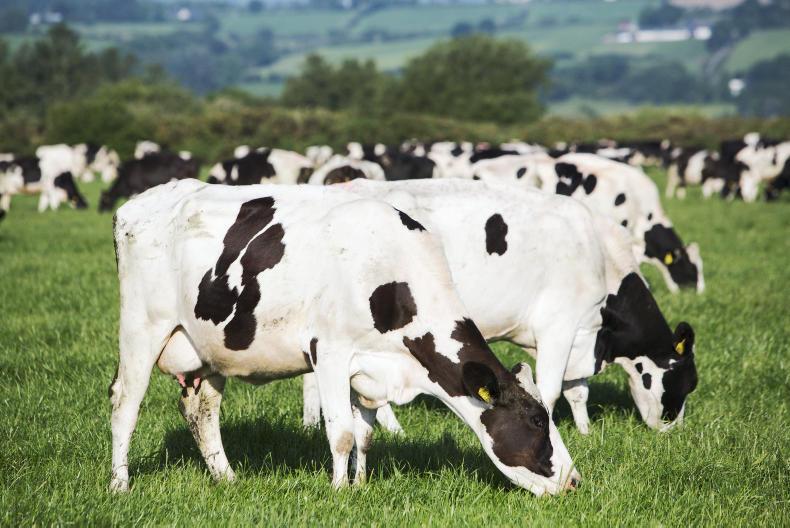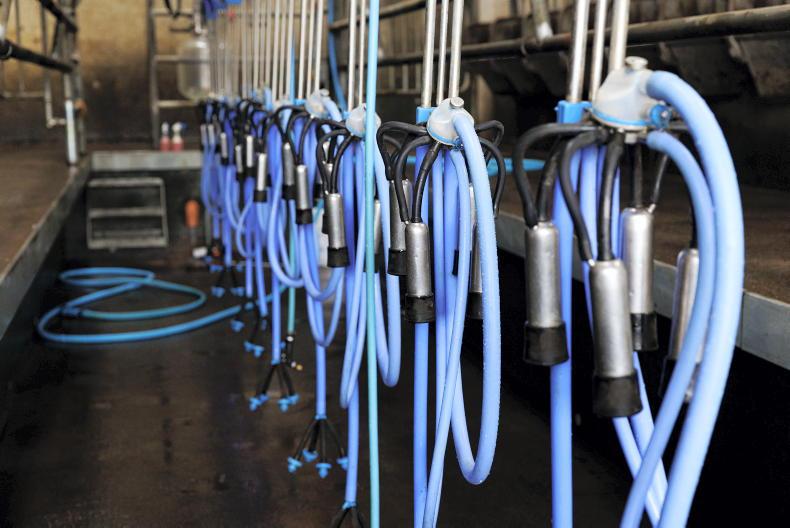In the last week, Lakeland unveiled a new €40m investment at its site in Bailieboro, Co Cavan, while LacPatrick unveiled a €40m investment in Artigarvan, Co Tyrone.
Next week, Dairygold will unveil its new powder plant at Mallow in Cork.
In total, over €300m invested in processing represents the real shift to produce and process more milk in rural Ireland.
Yes, there are new entrants to the sector but the majority of the additional milk is coming from existing dairy farms producing more litres.
Following the commissioning of the plants in Cavan and Tyrone, both now have 25% to 50% spare processing capacity.
While Northern Ireland milk sales are up this year, the level of expansion north of the border is not comparable to that taking place in the south.
It happened over the last 15 years as quota flowed in from the UK. Small percentage increases up or down in supply are now largely dependent on milk price and weather fluctuations.
We don’t want to end up with processing white elephants dotted across the country
The majority of the LacPatrick milk pool comes from Northern Ireland – over 80%.
With the acquisition of Fane Valley, Lakeland now has a milk pool of over 1bn litres with the split roughly 50/50 north and south.
The milk boom story south of the border is very real.
Farm businesses once strangled by an EU ceiling are free to supply as much milk as they choose.
The benefit of this to farmers, rural processing jobs, construction work and towns all around Ireland is evident.
With investments concluded, one would assume suppliers can expect better returns on milk price.
This unbridled enthusiasm for producing and processing more milk must be balanced with two things. Firstly, a fair price for the farmer as farmers create the benefit for everyone else. Secondly, the balancing act of a national strategy that can oversee a national investment plan.
We don’t want to end up with processing white elephants dotted across the country.
The chair of Lakeland is confident extra milk is coming from its suppliers, based on survey information. NI expansion won’t be as unrestrained but again LacPatrick is confident more milk will be produced.
The only way both businesses will be competitive long term is if they pay a competitive price. Both processors have lagged behind the pack in recent years.
No doubt some of these growth investments will have been financed from cashflow reserves.
The last thing we want is to see these spanking new investments become redundant in five years’ time.
With investments concluded, one would assume suppliers can expect better returns on milk price.
Of course, the financing package will also have made use of existing long-term funds and new loans.
Loans can be managed on a medium- to long-term basis for as long as the business remains viable.
The farmer directors that employ management to run and invest in both these co-ops have been brave in making these new investments.
As the saying goes, the empires of the future are the empires of the mind. However, at the same time, on a national level, we don’t want to follow the lead sheep falling over the cliff together.
The last thing we want is to see these spanking new investments become redundant in five years’ time.
Global boom in powder
European and global powder investments are booming. Within the last three years alone, the European Dairy Association reports that processors invested more than €6bn in processing capacity in Europe.
Half of this was spent on processing capacities for dry products such as powder and about 20% for cheese.
The biggest are the Chinese investing in powders in France and DMK in Germany.
Our Food Harvest 2020 report called for industry collaboration so that future investment and marketing could be strategically aligned. By and large, this has not happened.
Yes, some milk moves between processors but in the main that is as far as the collaboration goes.
Southern producers are on the cusp of delivering Food Harvest 2020 targets by the end of 2017.
Already some of the large processors in the south are talking about further investment on top of what has been spent in the last five years.
We need to be crystal clear that the investments are made in the right location so that, nationally, farmers’ money is not wasted on creating jobs and steel that only lasts for a very short time.
Read more
Lakeland tries to increase board term again
Weather not helping workload on autumn calving herds
In the last week, Lakeland unveiled a new €40m investment at its site in Bailieboro, Co Cavan, while LacPatrick unveiled a €40m investment in Artigarvan, Co Tyrone.
Next week, Dairygold will unveil its new powder plant at Mallow in Cork.
In total, over €300m invested in processing represents the real shift to produce and process more milk in rural Ireland.
Yes, there are new entrants to the sector but the majority of the additional milk is coming from existing dairy farms producing more litres.
Following the commissioning of the plants in Cavan and Tyrone, both now have 25% to 50% spare processing capacity.
While Northern Ireland milk sales are up this year, the level of expansion north of the border is not comparable to that taking place in the south.
It happened over the last 15 years as quota flowed in from the UK. Small percentage increases up or down in supply are now largely dependent on milk price and weather fluctuations.
We don’t want to end up with processing white elephants dotted across the country
The majority of the LacPatrick milk pool comes from Northern Ireland – over 80%.
With the acquisition of Fane Valley, Lakeland now has a milk pool of over 1bn litres with the split roughly 50/50 north and south.
The milk boom story south of the border is very real.
Farm businesses once strangled by an EU ceiling are free to supply as much milk as they choose.
The benefit of this to farmers, rural processing jobs, construction work and towns all around Ireland is evident.
With investments concluded, one would assume suppliers can expect better returns on milk price.
This unbridled enthusiasm for producing and processing more milk must be balanced with two things. Firstly, a fair price for the farmer as farmers create the benefit for everyone else. Secondly, the balancing act of a national strategy that can oversee a national investment plan.
We don’t want to end up with processing white elephants dotted across the country.
The chair of Lakeland is confident extra milk is coming from its suppliers, based on survey information. NI expansion won’t be as unrestrained but again LacPatrick is confident more milk will be produced.
The only way both businesses will be competitive long term is if they pay a competitive price. Both processors have lagged behind the pack in recent years.
No doubt some of these growth investments will have been financed from cashflow reserves.
The last thing we want is to see these spanking new investments become redundant in five years’ time.
With investments concluded, one would assume suppliers can expect better returns on milk price.
Of course, the financing package will also have made use of existing long-term funds and new loans.
Loans can be managed on a medium- to long-term basis for as long as the business remains viable.
The farmer directors that employ management to run and invest in both these co-ops have been brave in making these new investments.
As the saying goes, the empires of the future are the empires of the mind. However, at the same time, on a national level, we don’t want to follow the lead sheep falling over the cliff together.
The last thing we want is to see these spanking new investments become redundant in five years’ time.
Global boom in powder
European and global powder investments are booming. Within the last three years alone, the European Dairy Association reports that processors invested more than €6bn in processing capacity in Europe.
Half of this was spent on processing capacities for dry products such as powder and about 20% for cheese.
The biggest are the Chinese investing in powders in France and DMK in Germany.
Our Food Harvest 2020 report called for industry collaboration so that future investment and marketing could be strategically aligned. By and large, this has not happened.
Yes, some milk moves between processors but in the main that is as far as the collaboration goes.
Southern producers are on the cusp of delivering Food Harvest 2020 targets by the end of 2017.
Already some of the large processors in the south are talking about further investment on top of what has been spent in the last five years.
We need to be crystal clear that the investments are made in the right location so that, nationally, farmers’ money is not wasted on creating jobs and steel that only lasts for a very short time.
Read more
Lakeland tries to increase board term again
Weather not helping workload on autumn calving herds










SHARING OPTIONS